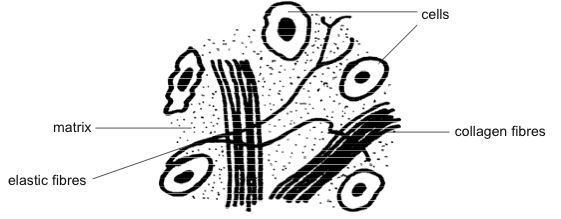Code TH H2.00.03.1.00002 | FMA 19783 | |
 | ||
Latin textus connectivus laxus TA A04.5.02.020A16.0.03.006 | ||
Loose connective tissue is a category of connective tissue which includes areolar tissue, reticular tissue, and adipose tissue. Loose connective tissue is the most common type of connective tissue in vertebrates. It holds organs in place and attaches epithelial tissue to other underlying tissues. For example, it forms telae, such as the tela submucosa and tela subserosa, which connect mucous and serous membranes to the muscular layer. It also surrounds the blood vessels and nerves. Cells called fibroblasts are widely dispersed in this tissue; they are irregular branching cells that secrete strong fibrous proteins and proteoglycans as an extracellular matrix. The cells of this type of tissue are generally separated by quite some distance by a gelatinous substance primarily made up of collagenous and elastic fibers.
Contents
Loose connective tissue is named based on the weave and type of its constituent fibers. There are three main types of connective tissue fiber:
Areolar tissue (/əˈriːələr/ or /ˌɛəriˈoʊlər, ˌær-/) is a common type of loose connective tissue (and the most widely distributed type of connective tissue in vertebrates). It is so named because its fibers are far enough apart to leave ample open space for interstitial fluid in between (areola is Latin for a "little open space"). It is strong enough to bind different tissue types together, yet soft enough to provide flexibility and cushioning. It exhibits interlacing, loosely organized fibers, abundant blood vessels, and significant empty space filled with interstitial fluid. Many adjacent epithelial tissues (which are avascular) get their nutrients from the interstitial fluid of areolar tissue; the lamina propria is areolar in many body locations. Its fibers run in random directions and are mostly collagenous, but elastic and reticular fibers are also present. Areolar tissue is highly variable in appearance. In many serous membranes, it appears as a loose arrangement of collagenous and elastic fibers, scattered cells of various types; abundant ground substance; numerous blood vessels. In the skin and mucous membranes, it is more compact and sometimes difficult to distinguish from dense irregular connective tissue.
Usually "loose connective tissue" is considered a parent category that includes the mucous connective tissue of the fetus, areolar connective tissue, reticular connective tissue, and adipose tissue.
Location
It may be found in tissue sections from almost every part of the body. It surrounds blood vessels and nerves and penetrates with them even into the small spaces of muscles, tendons, and other tissues. It may likewise be present in the mediastinal extremities. Nearly every epithelium rests on a layer of areolar tissue, whose blood vessels provide the epithelium with nutrition, waste removal, and a ready supply of infection-fighting leukocytes in times of need. Because of the abundance of open, fluid-filled space, leukocytes can move about freely in areolar tissue and can easily find and destroy pathogens.
The areolar tissue is found beneath the dermis layer and is also underneath the epithelial tissue of all the body systems that have external openings.
It is also a component of the lamina propria of the digestive and respiratory tracts, the mucous membranes of reproductive and urinary systems, the stroma of glands, and the hypodermis of the skin. It is also found in the mesentery which is surrounding the intestine.
Composition
It is a pliable, mesh-like tissue with a fluid matrix and functions to cushion and protect body organs.
Fibroblasts are widely dispersed in this tissue; they are irregular branching cells that secrete strong fibrous proteins and proteoglycans as an extracellular matrix.
The cells of this type of tissue are generally connected by a gelatinous substance known as ground substance primarily made up of collagenous and elastic fibers.
Function
Areolar connective tissues hold organs in place and attaches epithelial tissue to other underlying tissues. It also serves as a reservoir of water and salts for surrounding tissues. Almost all cells obtain their nutrients from and release their wastes into areolar connective tissue.
Classification
Loose connective tissue is named based on the "weave" and type of its constituent fibers. There are three main types:
